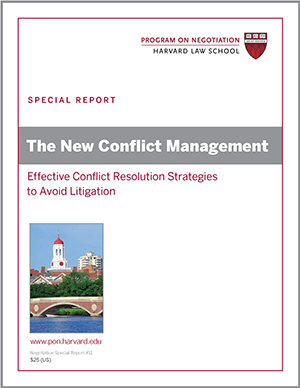
Business negotiators coping with deeply entrenched conflict often feel defeated and hopeless when conflict-solving strategies fail. However, research from the world of international conflict suggests that taking repeated breaks from conflict can improve the odds of reaching agreement down the road. The research and resulting negotiation strategies may offer new hope to business negotiators.
The Value of Cease Fires
Parties engaged in armed conflict often agree to cease-fires as a first step toward negotiating a peaceful resolution. Yet cease-fires and the agreements they inspire often are unstable, as recent real-life examples of conflict resolution efforts have shown.
In Colombia, for example, where the government and the Marxist guerrilla group FARC had been locked in conflict since 1964, four years of peace talks culminated in an agreement to end the conflict and forge a lasting peace on August 26, 2016. But on October 2, to the shock of both FARC and the government, the citizens of Colombia voted narrowly to reject the deal. The cease-fire nonetheless remained in place as negotiators went back to the table. The Columbian government and FARC signed a revised peace agreement on November 24, and the Columbian Congress approved the deal.
Also in October 2016, after Syrian and Russian air strikes on the Syrian city of Aleppo ended a cease-fire in the region, the United States suspended scheduled talks with Russia on negotiating a peace agreement in Syria. John Kerry, then the U.S. secretary of state, accused Russia of breaking its promises to end the air strikes and provide humanitarian aid to Syrians.
As these and other international conflict-resolution examples show, cease-fires can achieve their goal of helping to promote peace, but they sometimes fail. Nonetheless, the mere existence of cease-fires can ultimately promote a peaceful end to conflict, research shows.
Creating Virtuous Cycles
In a 2015 study of conflict and conflict-solving strategies, Notre Dame University researchers Madhav Joshi and J. Michael Quinn studied 196 cease-fire and peace deals dating from 1975 to 2011. They found that the greatest predictor of whether a peace agreement succeeded was whether the parties had reached prior cease-fires, even failed ones. The existence of such agreements had a greater influence on the success of peace deals and conflict-solving strategies than the duration or intensity of a war.
As compared to a lack of cease-fires, failed cease-fires “pave the way for better agreements down the road,” Quinn told the New York Times. Why? Because over time, parties begin to view cease-fires as less risky than continuing to fight. When parties have been willing to engage in cease-fires, they create a so-called virtuous cycle in which trust and goodwill gradually increase.
The findings suggest reason for hope that even deeply entrenched disputes can be addressed with effective conflict-solving strategies.
The Benefits of Punishment
In his research, University of Richmond professor Stephen B. Long found that when parties are punished for violating cease-fires, they become more likely to comply with future cease-fires. Punishment reminds parties of the benefits of cooperating rather than defecting. The Korean War, for example, has been virtually frozen for decades, in part due to each side’s belief that the other side will punish any renewed hostilities, notes the New York Times.
On the other hand, when parties are punished inconsistently or not at all for violating cease-fires, they are less likely to live up to their other promises. Such cheating breeds a vicious cycle of retaliation and recrimination. That’s in part why mediators can help parties resolve conflict: The threat that a mediator will punish cease-fire violations improves cooperation, according to the late political scientist Donald Rothchild.
Beyond Cease-fires
The research on cease-fires suggests the following three conflict resolution strategies for those embroiled in nonviolent personal or professional disputes:
- Take the long view. If early attempts to resolve your dispute fall apart, try to avoid viewing the effort as a failure. Instead, build momentum toward your next effort at forging peace, capitalizing on any trust you’ve gained.
- Apply punishments consistently. When counterparts violate the terms of an agreement—for example, by making inflammatory remarks in the midst of a cooling-off period—make sure they face repercussions for doing so.
- Involve conflict management Consider enlisting the help of a neutral mediator who can help parties uncover their deepest interests, brainstorm solutions, and hold both sides accountable for meeting their obligations.
What other conflict-solving strategies have you found to be effective in business negotiations and other realms?




